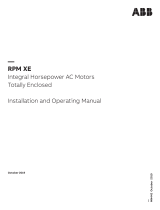
4
These safety instructions for the operation of
direct-current machines are in conformity with
the Low-Voltage Directive 73/23/EEC.
1
General
DC machines have rotating parts and parts
which may be live even at rest, and possibly
hot surfaces.
All operations serving transport, connection,
commissioning and periodic maintenance must
be carried out by skilled, responsible technical
person nel (note EN 60034; EN 50110-1/VDE
0105). Improper handling can cause serious
2
Intended use
injury and damage to property.
The applicable national, local and installa-
tion-specific regulations and requirements must
be taken into account.
To guarantee trouble-free operation the ABB
documentation must be followed.
These machines are intended for industrial and
commercial installations. They comply with the
standards series EN 60034 (VDE 0530). Their
use in hazardous areas is prohibited unless they
are expressly intended for such use (note addi-
tional instructions). Where, in exceptional cases,
– use in non-commercial installations – more
stringent requirements are to be met (e.g. pro-
tection against contact with children’s fingers),
these conditions must be ensured by the cus-
tomer when the machine is installed.
The machines are generally rated for ambient
temperatures of – 5 to + 40 °C and alti tudes of
up to 1000 m above sea level. Take note of dif-
ferent instructions on the rating plate.
Conditions on site must conform to all data giv-
en on the rating plate.
DC machines are components for installation in
machinery as defined in the Machinery Directive
89/392/EEC. Commissioning is prohibited until
conformity of the end product with this directive
has been established (see EN 60 204-1).
DC machines meet the requirements of the low
voltage directive 73/23/EEC.
The normal operation of the DC machine must
comply with the protection requirements of
the EMC directive 89/336/EEC. The proper in-
stallation (e.g. separation of signal lines and
power cables, screened cables etc.) is the re-
sponsibility of the erector of the installation. For
installations with power converters, the EMC
instructions of the converter manufacturer must
be taken into account.
3
Transport,
storage
Report damage discovered after delivery to the
transport company immediately. If necessary,
stop commissioning. Tighten screwed-in ring
bolts before transport. They are designed for
the weight of the machine. Do not apply extra
loads.
If necessary, use suitable, adequately di-
mensioned means of transport (e.g. rope guides)
.
When machines are stored, ensure a dry, dust-
free, low-vibration (V
rms
≤ 0.2 mm/s) environ-
ment (danger of bearing damage at rest). Long
storage periods reduce the grease service life
of the bearings. (Refer to the chapter “General
storage precautions”).
4
Installation
Make sure of an even supporting surface, of
solid foot or flange mounting and of exact align-
ment in case of direct coupling.
Avoid resonances in the operating speed range
and with sixfold (or, in the case of single-phase
supply, double) mains frequency which may be
caused by the assembly. Turn rotor by hand,
listen for abnormal scraping noises. Check
direction of rotation in uncoupled state (follow
Section 5.) Mount or remove output elements
(pulley, coupling) using only appropriate means
and cover them with a guard. Avoid excessive
belt tension (refer to DMI catalogue).
Before mounting the output element, make sure
the machine is balanced. The balancing method
for the machine is indicated on the shaft end
face and on the rating plate (H = half key, F = full
key).
For models with shaft ends pointing down-
ward, a canopy is recommended; for models
with shaft ends pointing upward, measures are
needed to protect against ingress of water into
the bearing.
Do not obstruct ventilation. Exhaust air, also
from neighbouring sets, must not be drawn in
again directly. Chemically polluted air, cooling
air containing dust, or low-load operation for a
prolonged period of time may negatively affect
the commutation and brush life.
Low-voltage
directive
Safety instructions

























